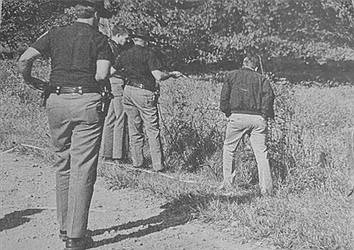Invasive Species: Garlic Mustard
March 15, 2023 at 6:10 p.m.

Garlic mustard, originally from Europe and Asia, has become a very troublesome invasive plant across the Northeast, Midwest and Northwest of the United States. Garlic mustard is a threat to the biodiversity (the variety of life on Earth and in a habitat) of many native ecosystems. This plant spreads its seeds in the wind and gains advantage by coming out earlier in spring than other native plants. By the time native species are ready to grow, garlic mustard has already established position to block their sunlight and take the available moisture and nutrients.
It is called garlic mustard because its leaves have a garlicky smell when crushed. Some of its nicknames are Poor Man's Mustard, Hedge Garlic, Garlic Root and Jack-by-the-Hedge. During its first year, garlic mustard leaves are rounder and take on a rosette formation at ground level. In their second year, the leaves grow up a flowering stem and become more triangular and heart-shaped with toothed edges. Small white four-petaled flowers emerge in the spring.
Garlic mustard is a threat to the biodiversity (the variety of life on Earth and in a habitat) of many native ecosystems. This plant spreads its seeds in the wind and gains a foothold in fields and forests by emerging earlier in spring than many native plants. By the time native species are ready to grow, garlic mustard has blocked their sunlight and outcompeted them for moisture and vital nutrients. Because the understory of a forest is so important for insects and other species at the bottom of the food chain, invaders like garlic mustard can weaken the entire ecosystem. Further, garlic mustard's roots release chemicals that alter the important underground network of fungi that connect nutrients between native plants, inhibiting the growth of important species like trees. Fortunately for us, we have options to rid ourselves of this pest of a plant.
Like many invasive species, garlic mustard require patience and persistence to get rid of. The ultimate goal in removing garlic mustard is to prevent new seeds from developing and spreading until the existing seeds are gone. This can be tricky and might take a couple years of vigilance, as garlic mustard can sprout up even when you're sure that you've gotten rid of every last one.
The best way to get rid of garlic mustard is manually, according to the USDA. Here are some other tips:
·Try to pull up the plants before they set seed, because the action of yanking the plant from the ground will spread the seed.
·A good time to pull garlic mustard is after it rains, when it's easier to get all or most of the long tap root.
·After you have pulled the plants, bag them up and throw them out with your garbage; do not compost.
·Clean off boots and clothes to further reduce the spread.
While getting rid of mustard garlic might look at first like an Insurmountable task, within a few clearing-efforts you'll see that native plants and even tree seedlings begin to steadily come back and repopulate an area. You are helping the ecosystem thrive!
You can eat that harvested garlic mustard if you'd like, though use caution, older plants contain cyanide and must be cooked thoroughly. Many European cultures used it for years as an added spicy-green to stews and salads.
Latest News
E-Editions
Events
Garlic mustard, originally from Europe and Asia, has become a very troublesome invasive plant across the Northeast, Midwest and Northwest of the United States. Garlic mustard is a threat to the biodiversity (the variety of life on Earth and in a habitat) of many native ecosystems. This plant spreads its seeds in the wind and gains advantage by coming out earlier in spring than other native plants. By the time native species are ready to grow, garlic mustard has already established position to block their sunlight and take the available moisture and nutrients.
It is called garlic mustard because its leaves have a garlicky smell when crushed. Some of its nicknames are Poor Man's Mustard, Hedge Garlic, Garlic Root and Jack-by-the-Hedge. During its first year, garlic mustard leaves are rounder and take on a rosette formation at ground level. In their second year, the leaves grow up a flowering stem and become more triangular and heart-shaped with toothed edges. Small white four-petaled flowers emerge in the spring.
Garlic mustard is a threat to the biodiversity (the variety of life on Earth and in a habitat) of many native ecosystems. This plant spreads its seeds in the wind and gains a foothold in fields and forests by emerging earlier in spring than many native plants. By the time native species are ready to grow, garlic mustard has blocked their sunlight and outcompeted them for moisture and vital nutrients. Because the understory of a forest is so important for insects and other species at the bottom of the food chain, invaders like garlic mustard can weaken the entire ecosystem. Further, garlic mustard's roots release chemicals that alter the important underground network of fungi that connect nutrients between native plants, inhibiting the growth of important species like trees. Fortunately for us, we have options to rid ourselves of this pest of a plant.
Like many invasive species, garlic mustard require patience and persistence to get rid of. The ultimate goal in removing garlic mustard is to prevent new seeds from developing and spreading until the existing seeds are gone. This can be tricky and might take a couple years of vigilance, as garlic mustard can sprout up even when you're sure that you've gotten rid of every last one.
The best way to get rid of garlic mustard is manually, according to the USDA. Here are some other tips:
·Try to pull up the plants before they set seed, because the action of yanking the plant from the ground will spread the seed.
·A good time to pull garlic mustard is after it rains, when it's easier to get all or most of the long tap root.
·After you have pulled the plants, bag them up and throw them out with your garbage; do not compost.
·Clean off boots and clothes to further reduce the spread.
While getting rid of mustard garlic might look at first like an Insurmountable task, within a few clearing-efforts you'll see that native plants and even tree seedlings begin to steadily come back and repopulate an area. You are helping the ecosystem thrive!
You can eat that harvested garlic mustard if you'd like, though use caution, older plants contain cyanide and must be cooked thoroughly. Many European cultures used it for years as an added spicy-green to stews and salads.





